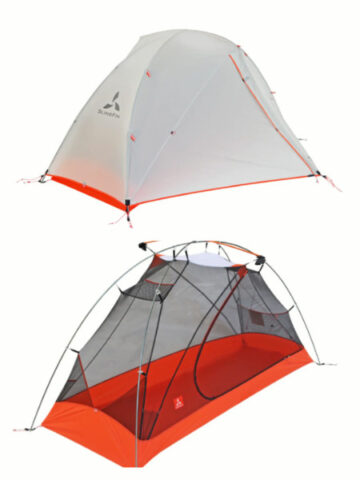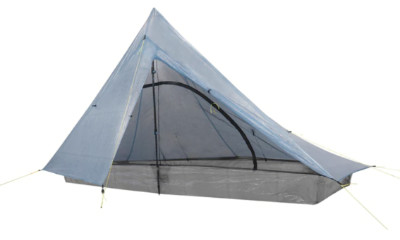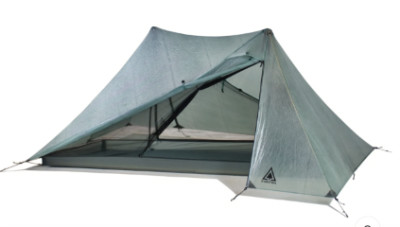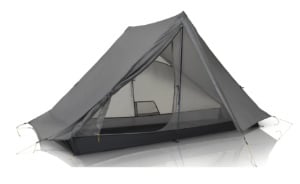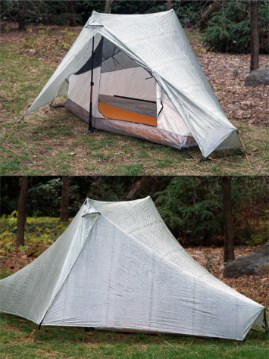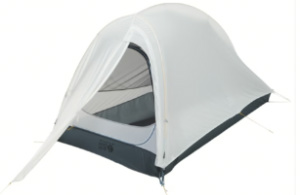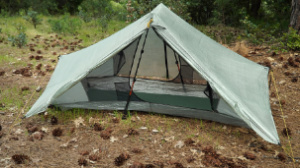One person, solo backpacking tents are ideal if you’re thru-hiking, fast-packing, or backpacking big miles and want to trim your gear weight as low as possible. More livable than bivy sacks, one-person tents are designed for sleeping and bad weather protection. While some solo tents are more plush and spacious than others, you almost always have to choose between competing priorities including weight, ease of use, durability, and cost when selecting one. This can make it tough to choose between tents, especially since few stores have display models anymore.
Taking these different priorities into consideration, here are our picks for the top 10 one-person tents of 2024.
1. Big Agnes Copper Spur HV UL1
The Big Agnes Copper Spur HV UL1 is a spacious, freestanding double-wall tent that’s easy to set up and has a trail weight of just 34 oz. With a “porchable” side door, a high vent, and two-way door zips, the Copper Spur has lots of options to vent extra moisture, increase airflow, and reduce internal condensation. The side door makes getting in and out easy and the large front vestibule lets you store gear without blocking access. A ceiling pocket, media pockets, and internal hang points help keep your gear organized and tucked out of the way. A longtime backpacker favorite, the well-appointed Copper Spur strikes an excellent balance between luxury and low weight.
2. NEMO Hornet OSMO Ultralight 1P
The NEMO Hornet OSMO Ultralight 1P is a 29 oz ultralight semi-free-standing double wall tent made with a nylon/polyester rain fly that won’t sag in the rain. It has a single side door with lots of mesh for ventilation and to help prevent internal condensation transfer. The side vestibule over the door provides plenty of gear storage without interfering with entry or exit. But the thing that sets his tent apart from others is the poles, which when collapsed are only 12.5″ long, making it possible to pack horizontally in almost any backpack! An even lighter weight, but more expensive version is available called the
NEMO Hornet Elite OSMO 1P which only weighs 23 oz, or for more interior space, the
NEMO Hornet Elite OSMO 2P which weighs 27 ounces.
3. Zpacks Altaplex
The 15.4 oz
Zpacks Altaplex is a single wall trekking pole tent made with Dyneema DCF which doesn’t stretch or sag at night and is extremely waterproof. It has a deep bathtub floor to keep you dry, steep walls to shed strong wind and snow, and a rainbow door that makes it easy to get in and out from either side of the front vestibule. While it is designed to accommodate taller people up to 6’6″ in height, it’s a favorite with many hikers because it has so much headroom and a 36″ wide bathtub floor so you can keep all your gear inside the tent at night, even though there is ample vestibule space in front of the door.
Shop at REI
4. Durston X-Mid Pro 1
The Durston X-Mid Pro 1 is a single-wall trekking pole tent made with ultralight Dyneema DCF. It is extremely easy to set up and requires 2 trekking poles to set up. It has a very spacious interior with a 32″ wide bathtub floor and is long enough to accommodate hikers up to 6’8″ in height. Numerous refinements make it quite livable including dual doors and vestibules, peak vents, and magnetic door toggles. The X-Mid Pro 1 is quite stormworthy and includes extra guy-out points for extreme conditions.
Shop at DurstonGear
5. Gossamer Gear “The One”
Gossamer Gear’s “The One” is an ultralight, single-walled trekking-pole tent that weighs 17.7 oz. It has a spacious interior that’s a palace for one, with excellent ventilation to help prevent internal condensation. Made with 10d Sil/PU ripstop nylon, the One is factory seam-taped so you can use it without seam-sealing. The front vestibule is quite large with a zippered center opening which can be closed shut in inclement weather, or rolled back for views and ventilation. The vestibule is also large enough to store your pack under half the vestibule and get in and out through the other.
Read our review.
Shop at Gossamer Gear
6. Six Moon Designs Lunar Solo
The Six Moon Designs Lunar Solo is an ultralight style, single-wall tent that’s pitched with a single trekking pole. Weighing 26 ounces, the Lunar Solo has a bathtub style floor to prevent flooding in the rain and a side door, making entry easy. The interior is quite roomy, with a hexagon-shaped floor, providing room to store your gear in the tent, and plenty of headroom to sit up inside. A large vestibule also provides gear storage. The Lunar Solo upper is made with a 20d silicone-coated polyester, reducing fabric stretch and packed volume, while the floor utilizes a durable 40D fabric.
Read the SectionHiker Review.
Shop at Six Moon Designs
7. SlingFin Portal 1
The SlingFin Portal 1 is a freestanding double-wall tent that’s a one-person version of their bomber
Portal 2-person tent, which we first used several years ago and also recommend highly. The Portal 1 is superbly made, and suitable for 3+ season camping with the ability to counter increased snow loads by combining tent poles and trekking poles for structural support. The inner tent has a deep bathtub floor for moisture protection with 7 internal pockets and 360 degrees of mesh providing excellent ventilation. There are also numerous plastic rings in the ceiling and corners that you can hang gear from, although they serve double duty as a unique internal guyline system to give the tent more stability in high winds when using external guylines
Read the SectionHiker Portal 1 Review.
Shop at SlingFin Tents
8. Tarptent Notch Li
The Tarptent Notch Li is a one-person, double-wall tent with two vestibules and two doors that weighs 21.4 oz. It’s a strong wind and weather-worthy shelter that is made with Dyneema DCF. Internal livability is excellent with plenty of headroom, space to accommodate a wide 25″ sleeping pad, and large vestibule spaces for gear storage, cooking in the rain, or a canine companion. Peak and end vents help maintain ventilation even in crappy weather. The inner tent can be set up by itself with trekking poles in dry weather and a solid inner tent is also available to extend the tent’s range in colder winter weather.
Read the SectionHiker Notch Review.
Shop at Tarptent
9. Mountain Hardwear Nimbus UL 1
The Nimbus UL 1 is a 27.8 oz semi-freestanding double-wall tent with a front door and vestibule. It packs up small and is very straightforward to pitch. The inner tent is 3/4 mesh with a high bathtub floor to keep pooling water out of the tent and provide enhanced dust and wind protection. The silicone-impregnated nylon fly is made without any fabric dye, significantly reducing the use of water and chemicals in the manufacturing process. The tent comes with Featherlite DAC aluminum poles which are pre-bent and connected by hubs to increase interior headroom and make the tent easy to set up. The beauty of a tent like this (without side doors) is that it’s much easier to find unprepared tent sites for it, especially in forested terrain.
10. Tarptent Dipole 1 Li
Weighing 20.8 oz, the
Tarptent Dipole 1 Li is an ultralight Dyneema DCF trekking pole tent with two doors and two vestibules. The tent has a rectangular footprint and requires two trekking poles to set up and 6 to 8 stakes depending on the degree of stability you prefer. It includes two carbon fiber struts that are used to increase the headroom at the ends and form covered awnings that can be sealed closed in high wind. The struts are collapsible so that the entire tent can be rolled up and packed horizontally in any backpack that’s at least 13″ wide (which fits most backpacks).
Shop at Tarptent
Tent Selection Criteria
Here are the most important variables to consider when buying a backpacking or camping tent.
WEIGHT/TRAIL WEIGHT – The total weight of a tent usually measures the tent and all of its packaging, while the trail weight is the weight of its poles, inner tent, outer rain fly, minus any tent stakes. Why the difference? Most people replace the tent stakes that come with a tent with lighter weight or stronger ones and leave all the extra stuff sacks and packaging at home rather than carry it.
DIMENSIONS – When selecting a tent, consider how much width, length, and height (headroom) you desire. Do you use a wide sleeping pad? How tall are you? Do you want to bring your gear inside the tent at night or are you ok with storing it under a vestibule? Do you want to be able to sit up in the tent or change your clothing? These are all factors to consider. When evaluating tent dimensions, make sure you, particularly if it is a double-wall tent, make sure you understand whether the stated dimensions measure the width and length of the interior and not the width and length of the rain fly, which is often much larger and can give the illusion of spaciousness.
TENT POLES – Tent poles are made using fiberglass, aluminum, or carbon fiber. Aluminum is the most durable of the three, while carbon fiber is normally only used in very high-end tents where the focus is on low weight. Fiberglass poles are the least durable tent poles and break frequently. So much so, that we recommend avoiding any tent with fiberglass poles. All the ones above have aluminum poles or use trekking poles. Most manufacturers who sell trekking pole tents offer regular tent poles as an add-on purchase.
DURABILITY – The floor of a tent is the part of a tent most likely to be punctured or torn as a result of ground abrasion. While using a footprint on floors that are 20 denier thick or less is always recommended, it’s far less necessary on 30 denier or higher floors, except on highly abrasive or rough terrain.
DOORS – Tents with two side doors are often preferable when purchasing a tent for two because it means each occupant can each get in and out without disturbing one another.
INTERIOR STORAGE – Interior pockets and storage organization is a plus in a multi-person tent. Look for internal pockets and gear loops to hang gear from the ceiling. A gear loft is an added bonus. Vestibule space is always a plus as well, but especially if there are multiple doors, so that gear storage does not block entry and exit.
VENTILATION – All tents experience tent condensation, but good tent site selection and ventilation are the best ways to avoid it. Look for tents that have lots of mesh netting to facilitate airflow, top vents to release moist air, and door tie-backs to roll up tent doors and keep them open at night.
Check Out All of SectionHiker’s Gear Guides!
SectionHiker is reader-supported. We only make money if you purchase a product through our affiliate links. Help us continue to test and write unsponsored and independent gear reviews, beginner FAQs, and free hiking guides.
